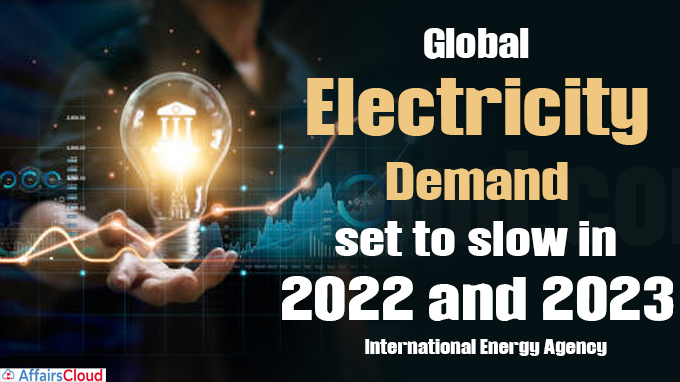
According to the July 2022 update of the Electricity Market Report, released by the International Energy Agency (IEA), global electricity demand growth is falling drastically in 2022 after a strong recovery in 2021 as economic development weakens and energy costs skyrocket following Russia’s invasion of Ukraine.
- A 2.4 % rise in global electricity demand is seen in 2022, which is less than the 3 % forecast made in January 2022.
- In 2023, it is expected to continue growing at a similar rate, down from a 6% rise in 2021 and in line with the five-year average prior to the COVID-19 pandemic.
Global Scenario
i. In Asia-Pacific, the growth in electricity demand is expected to be 3.4 % in 2022, and is expected to reach 4 % in 2023.
ii.In China, a 3% growth in demand is seen in 2022, while a 4% growth is expected in 2023.
iii. While growth in Europe is predicted to be less than 1% for 2022 with an uncertain forecast for 2023, growth in the Americas is expected to be 2% in 2022 and to drop below 1% in 2023.
iii.Demand in the Middle East is expected to rise up 2% in both 2022 and 2023, while demand in Africa is expected to rise up 4% in 2022 and 3% in 2023.
iv.Energy demand in Eurasia is expected to fall 1% in 2022, owing mostly to a deterioration in Russia’s economic outlook (which accounted for 80% of absolute electricity demand and demand growth in the region in 2021), and to fall 1% further in 2023.
Renewables Lead Supply Growth
i. The fastest-growing source of electricity supply in 2022 is likely to be Renewable Energy (RE), which is forecast to rise by 10%.
- Low-carbon energy is predicted to grow by 7%, outpacing demand growth and causing a 1% decline in total fossil fuel production.
ii.Globally, the growth of RE is expected to increase by 8% in 2023, which, when paired with nuclear power, could reduce consumption of gas and coal.
- After reaching an all-time high in 2021, increased usage of RE is expected to reduce global emissions by 0.5 % in 2022 and 1 % in 2023.
iii. However, global coal usage is likely to climb slightly in 2022 as Europe plans to switch to the more polluting resource in the short term in order to reduce dependency on Russian natural gas, boosting coal use by 8% in 2022 as gas declines by 7%.
- The higher use of coal is expected to make Europe the only country in 2022 to experience a rise in emissions of 3%, which is then expected to decline by 8% in 2023.
iv.Similarly, India is expected to increase coal use by 6% in 2022 while expanding renewable generation by 9%.
v.In China, coal-fired generation is predicted to dip by 1% for 2022, the first drop since 2015, with utilization in 2023 likely to compensate for the losses in 2022.
vi.Emissions in the Asia-Pacific region are set to decline in 2022, but they may increase by 1% in 2023 as extra demand growth outpaces development in RE generation.
IEA Revises India’s 2022 Electricity Demand Upwards: Electricity Market Report -July 2022
The IEA has increased India’s annual electricity demand from 6% to 7% in 2022 due to unusually high summer temperatures, leading to a considerable increase in consumption. Additionally, a 5 % growth rate is forecasted for 2023.
- The heatwave increased air conditioning use and led to new all-time highs in electricity consumption as well as a major increase in supply shortages.
- In recent years, India has been the second-fastest growing country in terms of absolute demand.
Major Predictions
i. The IEA expects that India’s coal consumption would rise due to increased demand. It was also observed that India’s renewable energy (RE) generation is aiding in addressing the rising demand for electricity.
ii.Similar to China, India is anticipated to grow its usage of coal by 6% while increasing its use of RE by 9%.
iii. IEA predicts that coal growth would drop to less than 2% in 2023. The majority of the additional generation is expected to come from RE, which may rise by more than 10%.
India’s Power Demand
i. In a report dated July 21, 2022, the ratings agency Crisil stated that it expects India’s electricity demand to increase by over 6% for the second consecutive Fiscal Year (FY), exceeding both pre-pandemic levels and the long-period average growth of 5%.
- This pattern of above-average growth is likely to continue for at least two more FYs.
ii.The Central Electricity Authority (CEA), Ministry of Power published the Load Generation Balance Report (LGBR) 2022–23, which assessed that the total energy requirement for India is 1,505.20 Billion Units (BU), compared to the assessed energy availability of 1,549.60 BU for FY 2022–23 (FY23).
iii. In order to meet India’s rising energy needs, conventional thermal projects totalling 27,550 megawatts (MW) and conventional hydroelectric projects with a capacity of 14,103.50 MW are presently under construction in the country.
- Furthermore, 8,700 MW of nuclear power projects are under construction.
About International Energy Agency (IEA):
Executive Director – Dr. Fatih Birol
Established – 1974
Headquarters – Paris, France




